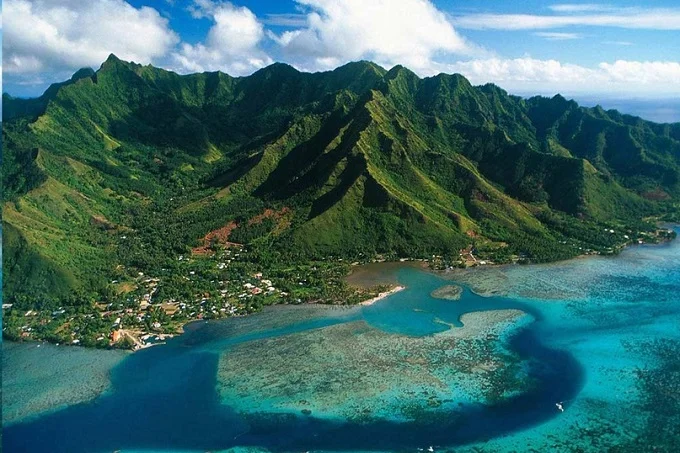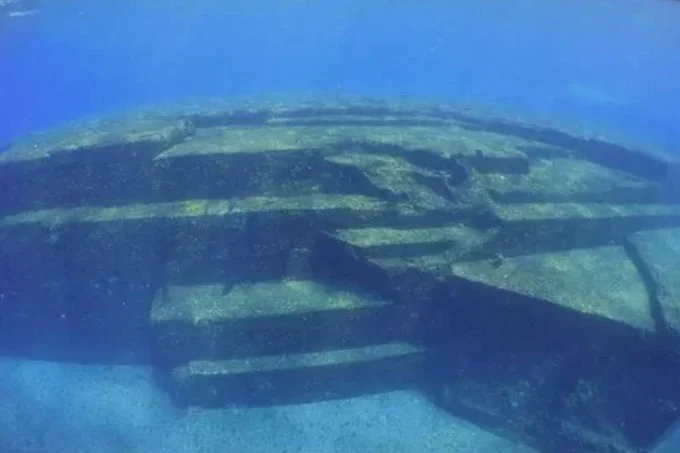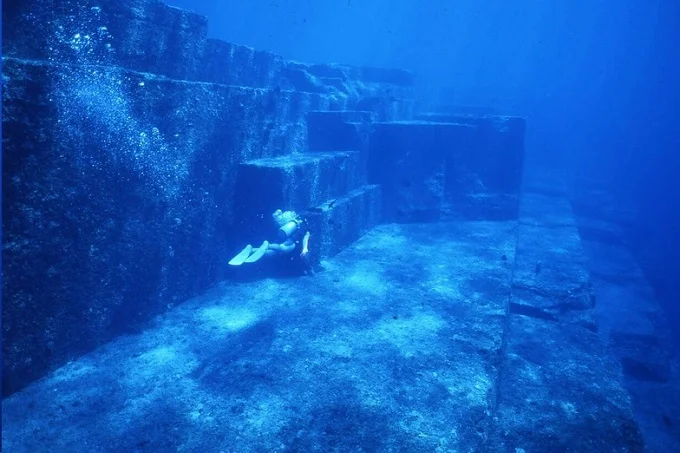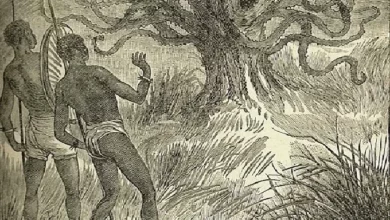Is Madagascar the remnants of the Lemuria continent?

Is Madagascar the remains of an ancient lost continent? By the middle of the nineteenth century, the rapid development of science and technology made it possible to introduce some variety into the centuries-old dogmas about the origins of our planet and life on it. The age of steam and electricity made it possible to explore areas of the globe, little explored by Europeans.
In particular, explorations of the island of Madagascar led to startling discoveries. Despite its proximity to Africa, most of the plants and animals living in Madagascar turned out to be endemic (living only in this place), and their number is so great that the island may well be considered part of a continent. Its indigenous inhabitants are not of the Negro race but much closer to the inhabitants of Indonesia.
This is when the theory of a lost continent or chain of islands in the Indian Ocean that once stretched from Africa to Sumatra and India emerged. The name of this hypothetical Indo-Madagascar landmass was suggested in 1858 by the British zoologist Philip Lutley Sclater after the amazing creatures that Europeans encountered on Madagascar.
These nocturnal animals, with luminous eyes, voices resembling howls or cries, and an appearance that bizarrely mingled human, cat, and bear cub features, were called lemurs. The ancient Romans called the souls of men who had not found shelter in the afterlife by the same name. By naming the drowned continent Lemuria, Sclater wanted to emphasize its uniqueness.
The following year Charles Darwin published his “On The Origin of Species”, and 15 years later, the German naturalist and philosopher Ernst Haeckel suggested the existence of an intermediate form between apes and humans. He did not rule out that these missing steps were lost along with Lemuria.
Heckel’s idea was supported by Thomas Heckel, Alfred Wallace, Rudolf Virchow, and other authoritative scientists of the time. “Many hundreds of millennia ago, at a period not yet precisely defined in what geologists call the Tertiary, presumably towards the end of that period, there once lived in a hot belt – most probably on a vast continent now submerged at the bottom of the Indian Ocean – an unusually highly developed breed of great apes,” wrote Friedrich Engels in his famous work “The Role of Labor in the Process of Turning Apes into Men.”
So already in the 1880s, Lemuria became the subject of one of the scientific theories.
One of the largest geographers, Jean-Jacques Elise Reclus, supported this theory, a tireless traveler and revolutionary, a member of the First International and a member of the Paris Commune. In the volume of his monumental work “Earth and People” dedicated to the ocean and ocean lands, where for the first time a detailed description of all countries of the world was given, he wrote that Madagascar is a wreck of a sunken continent, for a while “the ocean islands are extremely poor in mammals, Madagascar has no less than 66 species of them, which is enough to prove that this island was once a continent.”
According to the famous French geologist Academician Gustave Emile Aug, “the Indian subcontinent, the Seychelles and Madagascar are fragments of the continent that occupied the place of the modern Indian Ocean or a part of it.” He called this sunken continent Australian-Indo-Madagascar and believed that a depression formed in the eastern part of the Indian Ocean after its death.
The academician’s correctness was confirmed in 1906 by the German research ship Planet by discovering the Sunda, or Javan, trench – the deepest oceanic depression in the eastern part of the Indian Ocean. It stretches for 4000 km from the mainland slope of Myanmar towards the island of Java along the southern part of the Sunda island arc and is still seismically active.
The belief in the existence of the disappeared continent in the Indian Ocean was fueled by the study of the folklore of the peoples of this region. One of the ancient texts of Sri Lanka says: “In time immemorial, the citadel of Ravan (ruler of Sri Lanka) consisted of 25 palaces and 400 thousand inhabitants, subsequently absorbed by the ocean.”
As the text says, the sunken land was located between the southwestern coast of India and the island of Manar off Sri Lanka. This land, of course, was not a continent (if it existed at all), but represented only part of the land.
According to the myths of the Malgache, Madagascar used to stretch far to the east, but most of it was destroyed by a semblance of a worldwide flood. Another cultural tradition, according to D. S. Alan and J. W. Delair’s Evidence from a Cosmic Catastrophe 9500 BC.”, claims that the sunken land was in the area of the Myeik (Mergui) archipelago off the southern coast of Burma (now Myanmar).
One of the ancient Tamil epics often mentions the vast land of Kumari Nalu (later identified by the Europeans with Lemuria), which stretched far into the Indian Ocean from the shores of present-day India. According to Dravidian myths, from time immemorial, there existed a poetry academy headed by Shiva, with which the emergence of Tamil poetry is associated.
But the ancestral home of the Tamils, as the legend says, “was destroyed and swallowed up by the sea.” From it remained the small islands of the Indian Ocean and Indonesia. Those who managed to escape settled on nearby lands or on the remnants of the continent that remained above the water.
And finally, the most popular Indian epic “Mahabharata” dating back to the 5th millennium BC., places his hero Rama on a high mountain, from where he gazes over the horizon on land, in the place of which the waters of the Indian Ocean are now splashing. In the same work, for the first time in history, a wheel is mentioned, as well as mysterious vimanas – flying machines set in motion by the effort of thought, and other miracles of the ancient gods. It also describes a destructive war that is possible only with the use of nuclear weapons.
The hypothesis of the existence of Lemuria received the most massive support from representatives of mystical societies, who included the sunken continent and its inhabitants in their schemes of human development. Our civilization was preceded by the Atlantean civilization, declared the Rosicrucians and members of the Theosophical Society. But the Atlanteans also had their predecessors and teachers – the inhabitants of the sunken Lemuria.
“Lemuria was then a gigantic country. It covered the entire region from the foothills of the Himalayas to the south through what we now know as South India, Ceylon, and Sumatra; then, enveloping on its way, as it moved southward, Madagascar on the right and Tasmania on the left, it descended, not reaching a few degrees to the Antarctic Circle; and from Australia, which at that time was inland on the Mainland, it extended far into the Pacific Ocean beyond Rapa Nui. Sweden and Norway were an integral part of Ancient Lemuria, as well as Atlantis from the European side, just as Eastern and Western Siberia and Kamchatka belonged to it from Asia,” writes Blavatsky.
According to occultists, the civilization of the Lemuro-Atlanteans was the most developed civilization in the world. They were deeply versed in the mysteries of nature; they did not have religion because they did not know dogmas and did not have convictions based on faith. Lemuro-Atlanteans built huge cities, carved their own images from stone.
The oldest remains of cyclopean structures are also their works. Their aircraft, on which they could leave the Earth, were set in motion by the power of mantras, that is, special spells uttered by a person advanced in spiritual life.
Helena Blavatsky argued that “the history of the primordial races is buried in the grave of time, not for the Initiated, but only for the ignorant science.” In her Secret Doctrine, she described that there were five races of people on Earth. The first – “self-born” were angel-like creatures 50-60 m in height, had one eye (the one that we now call the third), and multiplied by division.
The second race of “sweat-born” or “immortals” were ghost-like creatures about 40 m tall, also one-eyed, but reproducing by budding and spores. The third race, called the “twofold”, “androgyne” or “Lemurian”, had the longest period of existence and the greatest variability within itself.
Within this race, a division of the sexes took place, bones appeared, the body thickened, and from four-armed and two-faced about 20 m in height, they turned into two-armed and one-faced already smaller in size. Representatives of the fourth race, called Atlanteans, were two-handed and one-faced, about 6-8 m tall, and had a dense body. The fifth, Aryan, race is already our civilization.
There were also more amusing revelations. One of the most famous figures and lecturers of the Theosophical Society, Charles Webster Leadbeater, reported that although the growth of the Lemurians reached 10 m, their purebred descendants are the pygmies of Central Africa and the stunted inhabitants of the Andaman Islands in the Indian Ocean. Their eyes were behind the head; initially, they were bisexual, but then fell into sin, having entered into a relationship with animals, and eventually gave birth to… monkeys.
In the writings of the Rosicrucians, the Lemurians were given an even more fantastic appearance. Instead of eyes, two sensitive spots perceived the light of the sun, “shining dimly through the fiery atmosphere of ancient Lemuria.” They spoke in a language consisting of sounds similar to the sounds of nature: the howling of the wind, the murmur of a stream, the sound of a waterfall, the roar of a volcano.
“Venice” of the Pacific Ocean – Nan Madol – ninety-two(!) Man-made islands, built on a coral reef and occupying an area of about 130 hectares. Remnants of Lemuria?
Such a “contribution” of the mystics to the search for hypothetical sunken lands ended with the fact that the topic of Lemuria, already controversial enough, was for a long time discredited in the eyes of most scientists. There were practically no expeditions to study it, a few studies did not find any traces of the existence of a large island or continent.
And the famous theory of continental drift, proposed by the German geographer Alfred Wegener in 1913, excluded the idea of sunken continents from scientific use. The hypothesis of the so-called uniformization prevailed, affirming the evolutionary, calm, and, to a certain extent, monotonous nature of the developed planet Earth.
However, numerous enthusiasts did not let Lemuria “drown” completely
In 1926, 75-year-old metallurgical engineer James Churchward published The Lost Continent of Mu. He argued that in the 70s of the XIX century. During his military service in India, he met the abbot of one of the ancient temples, who later became his teacher. This monk showed him ancient tables that mentioned the continent of Mu (Lemuria), which stretched for 6,000 km from the northern tip of Hawaii to Fiji and Easter Island.
Churchward portrayed the sunken continent as a kind of earthly paradise, home to 64 million inhabitants, led by a priestly caste – the so-called Naacals. The civilization of Mu, according to him, had about 50 thousand years of history and gave birth to the civilizations of Atlantis, Maya, Babylon, India, Egypt, Persia, and others, whose age is much older than the official history claims. All of these cultures were colonies of Mu, which was originally the only one on Earth. About 12 thousand years ago, volcanic eruptions, earthquakes, and tsunamis destroyed Lemuria.

Churchward wrote that an Indian priest taught him the secret language of Naacal, known to only three people on Earth, thanks to which he was able to read the historical and religious documents of Mu. However, these sources were not enough, and Churchward began to study the antiquities of all the peoples of the world.
He stated that the commonality of the religious ideas of mankind testifies to the origin of all religions from the cult of the Sun, which in the language of the Lemurians was called Ra. Naacali used the same term to refer to their ruler.
Despite the dismissive attitude of scientists and devastating scientific criticism, this and subsequent books by Churchward about the continent of Mu became bestsellers. They are still being published. The hypothesis of large-scale cataclysms in the history of the Earth was also revived. Many geologists also wrote in the 1950s and 1960s that dry land could once have been on the site of the Indian Ocean.
If not the entire ocean, then its northwestern part, for the granite massifs of East Africa, the Arabian Peninsula, and Hindustan find their continuation within the bottom of the Indian Ocean.
A similar point of view was shared by the prominent Soviet geomorphologist O.K. Leontyev, Professor D.G. Panov, Corresponding Member of the USSR Academy of Sciences V.V. land areas.
The first evidence of the former land’s existence on the site of the Indian Ocean was obtained by the Swedish research ship Albatross in 1947. A few hundred miles off the southeastern coast of Sri Lanka, he discovered a vast underwater plateau, which is a mass of solidified volcanic lava.
During the eruption of a volcano (or volcanoes), lava filled the valleys that were not yet sunken at that time. It is possible that this cataclysmic cataclysm coincided with the sinking of the kingdom of Kumari Nalu. The aforementioned A.S. Alan and J.V. Delair date this event to 9500 BC. And in 1985, Japanese diver Kihachiro Aratake, lost outside the standard security perimeter off the southern coast of Okinawa, discovered ancient Cyclopean structures on the seabed near the tiny island of Yonaguni. The following year, another diver saw underwater a massive arch made of huge stone blocks, fitted together with filigree precision.
Inspired by the opportunity to find new submerged structures, teams of divers went underwater from the southern coast of Okinawa, setting off on pre-planned routes. Soon the efforts of the enthusiasts were rewarded with further discoveries: before the onset of autumn, at different depths, five more archaeological sites were discovered near three islets – Yonaguni, Kerama, and Aguni, and the buildings, with all the variety of architectural details, had a stylistic unity.

In the spring of 1998, near the island of Okinoshima in the Korean Strait, separating Japan from South Korea, Japanese divers found four round stone towers at a depth of 30 m, which rose 27 m above the bottom. At the same time, one of them had a spiral staircase that wrapped around the tower along the outer contour…
In addition, in the waters of the ocean, buildings were discovered, similar to rectangular crypts near the settlement of Noro on the same Okinawa. Interestingly, the inhabitants of this southernmost island belonging to Japan call the crypts “moai”, just as the inhabitants of Easter Island call their famous statues. The great god-enlightener of Easter Island Make-Make sailed, according to the legends of the aborigines, from the drowned island of Motu-Mario-Khiva.
Oddly enough, the first ten years after the discovery of underwater megaliths, the scientific community ignored their existence. Once again, no one wanted to rewrite history: after all, the Okinawan buildings are over 10 thousand years old. Therefore, historians preferred to consider the find bizarre play of nature.
All these years, the Yonaguni complex has been studied by Masaaki Kimure, professor at Ryukyu University, an expert in marine geology and seismology. Having made more than a hundred dives, he decided to go against the opinion of the overwhelming majority of historians and put his reputation on the line, defending the artificial origin of the Yonaguni structures.
After arguing for some time, scientists came to a compromise: they decided that people changed and modified the original natural “preparation”. Such so-called terraformations were not rare in the ancient world.

Nowadays, even in Japan, even academic science adheres to either such a compromise point of view or considers the underwater structures of Yonaguni to be uniquely man-made. And who knows if these were not the hands of the notorious Lemurians?




